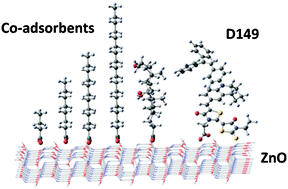Amphiphilic acids as co-adsorbents of metal-free organic dyes for the efficient sensitization of nanostructured photoelectrode
Abstract
Photoelectrode sensitization is an important step of metal-free organic

* Corresponding authors
a
Laboratoire d'Electrochimie, chimie des Interfaces et Modélisation pour l'Energie, UMR-CNRS 7575, Chimie-Paristech, 11 rue P. et M. Curie, 75231 Paris cedex 05, France
E-mail:
thierry-pauporte@chimie-paristech.fr
Fax: (33)1 44 27 67 50
Tel: (33)1 55 62 63 83
b Saint-Gobain Recherche, 39 quai Lucien Lefranc, 93303 Aubervilliers Cedex, France
Photoelectrode sensitization is an important step of metal-free organic

 Please wait while we load your content...
Something went wrong. Try again?
Please wait while we load your content...
Something went wrong. Try again?
C. Magne, M. Urien, I. Ciofini, T. Tugsuz and T. Pauporté, RSC Adv., 2012, 2, 11836 DOI: 10.1039/C2RA22121G
To request permission to reproduce material from this article, please go to the Copyright Clearance Center request page.
If you are an author contributing to an RSC publication, you do not need to request permission provided correct acknowledgement is given.
If you are the author of this article, you do not need to request permission to reproduce figures and diagrams provided correct acknowledgement is given. If you want to reproduce the whole article in a third-party publication (excluding your thesis/dissertation for which permission is not required) please go to the Copyright Clearance Center request page.
Read more about how to correctly acknowledge RSC content.
 Fetching data from CrossRef.
Fetching data from CrossRef.
This may take some time to load.
Loading related content
